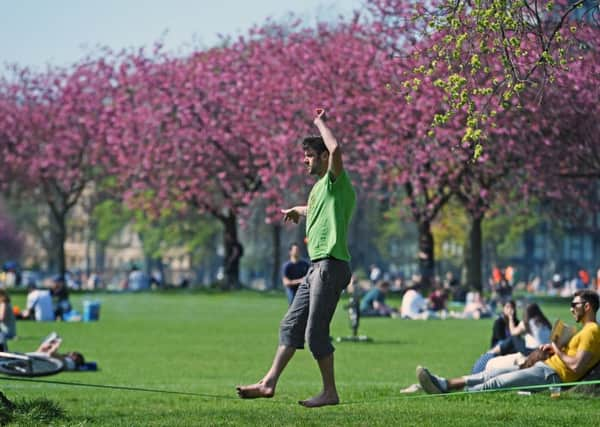Will the Edinburgh of 2030 put people or profit first? – Cliff Hague


What sort of place will Edinburgh be at the end of the new decade? If trends from 2010-2019 are carried forward, it will be a bigger city, spreading out across the old green belt.
The population is expected to grow by 7.7 per cent from its current 520,000, adding roughly another 40,000 people. Where will the extra houses be built?
Advertisement
Hide AdAdvertisement
Hide AdMurray Estates has planning permission for a development of 6,200 houses on former green belt land between the city bypass, Riccarton and the A71. However, they are unlikely to build them all in the immediate future: rising house and land prices make it more profitable to phase a development gradually, using the asset value to secure other investment opportunities.
The Granton-Newhaven area, where development stalled after the 2007-08 financial crash, will finally get built up, aided by the arrival of the trams that will improve accessibility to the rest of the city. We should also expect housing development in corridors to the east and south east, and substantial development in the Lothians.
One important question is what kind of housing do we want? The current target is that 25 per cent should be affordable, but is that enough? Unless it is regulated quickly – and there is no sign that the Scottish Government is in a rush to do so – short-term holiday letting will continue to be attractive to national and international investors and by 2030 these may have emptied the Old Town and much of Leith and Gorgie/Dalry of the stock of affordable rental apartments.
Similarly, if the universities continue to expand at their present rates, we should expect the number of students studying in the city to approach 80,000, some 18,000 more than at present.
Tourist ghost town?
Then there is tourism. By 2030, a tax on visitors staying in hotels is likely and the angry reactions to Underbelly’s Christmas and Hogmanay may have been translated into a much-downsized set of celebrations. If the industry lobby is correct this combination of possibilities will make Edinburgh a tourist ghost town. So could it be that the world-class ‘Virgin Money Arena’, designed to host five major events each year (of unspecified duration), in what is currently called “West Princes Street Gardens” will stand empty by 2030? Probably not. On present trends, expect tourist numbers to reach six million a year by 2030. There must be potential for a new Summer Solstice festival – why not make money from those long hours of daylight? And how about a week-long ‘Harry Potter Fest’? We will need more hotels, though with less staff, in the city centre and Old Town, and in Leith/Newhaven, where the cruise boat terminal will be.
The successful commercialisation of Princes Street Gardens might spill over to other former park areas, with the East Meadows the most likely candidate, given the development potential of its location.
It is difficult to anticipate how new technologies may change our lives in the new decade. However, a couple of innovations are predictable as they are already in production – electric vehicles and autonomous vehicles. Another ten years of growth in the Edinburgh region, as sketched above, will create increased concern over movement in and around the city. A switch to electric cars should help deliver better air quality, and with so many tenements, we should expect a growth of rapid-charging stations, perhaps in former petrol forecourts or empty retail parks.
‘Zombie cars’ endlessly circulating
Driverless cars and lorries will change our cities and regions. They could lead to car sharing and reduced car ownership, with less need for parking at both origins and destinations, freeing up space for other uses. City centre parking would be a thing of the past, and suburban streets decluttered as people dial up a vehicle from a storage area on cheap land outside the city. They will take up less road space as they can drive safely more closely together: imagine autonomous lorry lanes on the motorways and by-pass, and driverless buses. But there would be significant impacts on jobs.
Advertisement
Hide AdAdvertisement
Hide AdThere is also the prospect of “zombie cars” cruising around our streets in the hope of locating customers. As the price of a driverless car falls over time, we might expect that people would be more willing to commute longer to work: instead of being squeezed into a late-running train between Falkirk and Edinburgh, people are likely to opt for cheaper, more rural housing, knowing that they can watch a film or do office work in comfort during their driverless commute. But will cars still be allowed in the city? Already there are moves to shift us towards more active and sustainable forms of travel – cycling, walking, public transport – with increasing restrictions in the city centre, and talk of a congestion charge to drive into the city at all. Will Edinburgh finally get a tram network rather than just a tramline?
The scale of growth in the region will require some serious investment in infrastructure, and strategic decisions about where development should go. In China, fast trains have dramatically extended commuting areas, making the equivalent of Edinburgh to Aberdeen a 45-minute ride. In the US and China, tech giants are now building their own self-contained out-of-town campuses. In Toronto, Alphabet is building a “smart city of the future” along the waterfront. How would Scotland’s planners react if sometime between now and 2030, a major hi-tech campus village was proposed somewhere between the airport and South Queensferry?
All these pressures will be played out against mounting concerns over the climate emergency. The greenest building is an existing building, and we need to conserve our trees and open spaces. Can we plan for a future that prioritises the environment and well-being, or will GDP remain the ultimate measure of success?
Professor Cliff Hague is chair of the Cockburn Association
